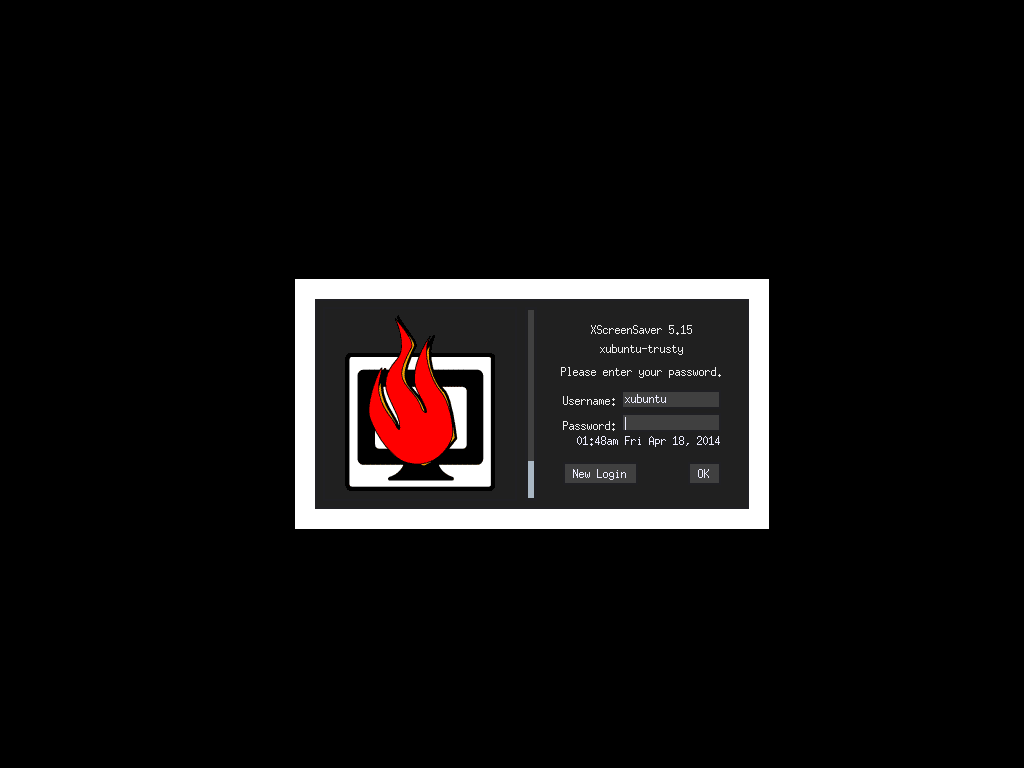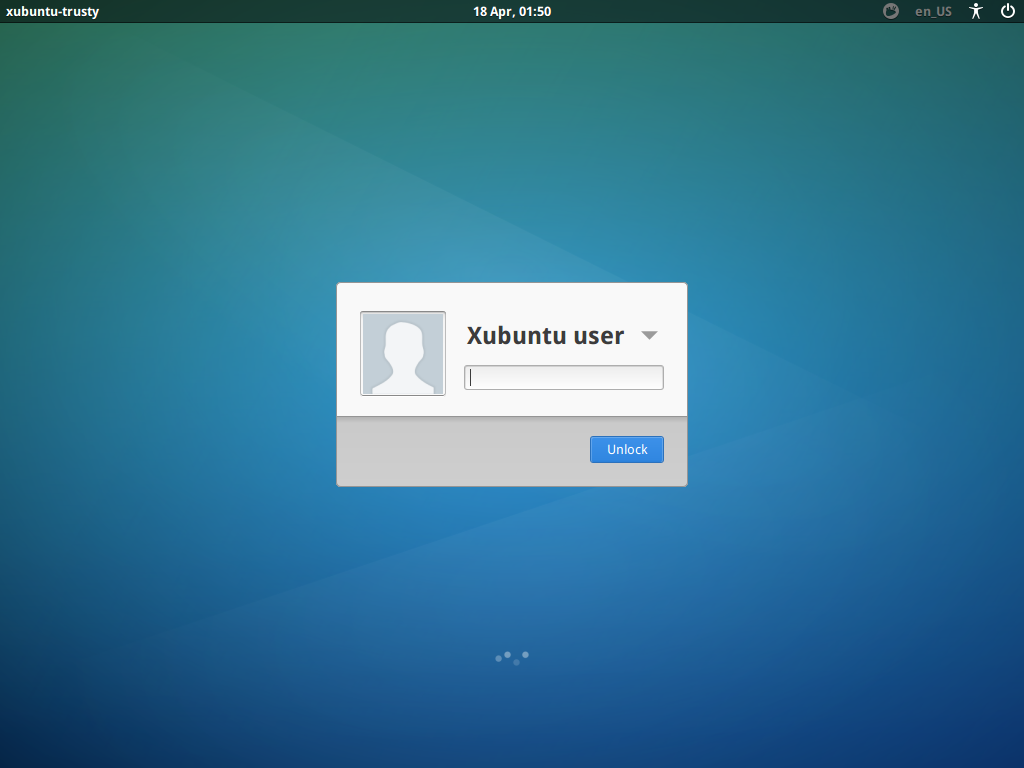Improving screenlocking (or: sessionlocking) has been on our agenda for a few cycles now. We’ve used the old and proven XScreensaver for a few releases, but people have always complained about its antiquated looks (which are also not customizable). Switching to gnome-screensaver wasn’t an option because of the additional package dependencies. Furthermore, after gnome-screensaver 3.6, locking became more tightly integrated into Gnome-Shell, which is why Ubuntu/Unity kept version 3.6 and has maintained it for a few releases now.
Starting with 14.04, Ubuntu/Unity have switched to a new solution for locking, and so have we.


The solution Xubuntu uses in 14.04 is called light-locker. The light-locker project is a fork of gnome-screensaver 3.6, but cut down to a bare minimum (so no gnome-dependencies), using LightDM’s greeter as the lock (and unlock) screen.
How does the screenlocking work?
There aren’t too many changes for users. The light-locker process operates in the background and people can still lock their session in the ways they used to (e.g. through Whiskermenu’s lock launcher or through a keyboard shortcut invoking “xflock4”).
Settings are configurable via a settings dialog developed for Xubuntu 14.04, called Light Locker Settings. The tool can be found in the the Settings Manager. It allows you to configure whether your session should be locked automatically after a timeout and the screen-blank and off times. The dialog is still, for the moment, basic, but it should allow you enough control. Refinements are planned for future cycles/releases.
One thing that changes for users is the fact that locking with LightDM means that a new virtual terminal is opened. In a default single-user session, the user’s X session rests at VT7 (reachable with the keyboard-shortcut Ctrl+Alt+F7). When you lock your session, LightDM sends a lock signal, light-locker locks the session on VT7 and you get forwarded to VT8, where you’re presented with the login greeter, which serves as the unlock dialog.
The aforementioned change introduces one inconvenience you might (or might not) notice: when light-locker switches the VT, there is some screenflickering and it could take a second or two on older machines.
What happened to my music playback?
As your seat becomes inactive, your audio stream is stopped/paused until you log into your session again. This is one of the known issues of light-locker or locking with LightDM in general.
Currently, when locking, it is assumed you are either:
- in a public space of sorts (the desktop at home hardly needs locking) and have walked away from the machine
- using a system with more than one user
Stopping/pausing playback in both of these scenarios make sense.
However, this might be an annoying change for users used to having their music playback continue even when their session locks. If you don’t like this behavior, there are basically two solutions:
- Set light-locker to lock the session “When the screensaver is deactivated”
- Switch back to using xscreensaver
- Add your user to the “audio” group on your computer and music playback will continue also with light-locker
The first option is a good workaround, because it means that your audio-playback will continue when the screen has been blanked. However, when you wake up your computer, e.g. by touching the mouse, it will pause the music until you log into your session again. The third solution is mentioned last, because it isn’t advised to add your user to the “audio” group (read The Audio Group wiki page for a comprehensive explanation). However, as long as you’re on a single-user system, this might still be an option for you.
Can I have a screensaver other than the blank screen with light-locker?
In a word – no.
If you need a screensaver for whatever reason, perhaps using a TV for a monitor and don’t want a blank screen, then you will need to remove light-locker and install some alternative, like xscreensaver.
Conclusion
From Xubuntu 14.04 on, we can finally provide a visually consistent way of logging in to and locking your session with light-locker. As mentioned above, there is a conceptual change in how we look at locking in Xubuntu (which to some might seem like a small regression), however, there are still good alternatives for those who don’t agree with our vision.
Known Issues
Currently, you might run into this known issue (that we discovered only when the release was already imminent), which we’re already working on fixing:
- Xfce4 Power Manager does not restore screen power (1259339) – see the release notes for details and workarounds
Also, upgraders from previous Xubuntu versions might run into trouble because XScreensaver and light-locker are both installed. Just get rid of one of the two to resolve that.
Now that Trusty is out the door, we thought that the time was right to bring you a recap of what you’ve managed to do for Xubuntu during the last cycle and what we’ve been up to behind the curtain. Those of you who frequent the #xubuntu-devel channel are likely aware of how much the work people testing do is appreciated. The remainder of you perhaps don’t, or just assume so.
So without further dithering I’ll get right on with it.
Package Testing
Following on from the huge effort made during the Saucy cycle to create new testcases, we were able to use this work during the whole of this LTS cycle. For the first time Xubuntu were able to use specific tests for the applications and packages as well as images. There are in excess of 200 reports recorded in the package tracker for this last cycle. It does make life a lot easier to know we have this availability, the reported bugs make it onto a blueprint from where we can monitor progress during the cycle. Whether we use the same entire set of tests for the next cycle is not set yet, possibly we’ll work differently in non-LTS cycles.
For the various sections we have on our tracker
- Xfce Applications (8 tests) - 58 reports
- Xfce Core (9 tests) - 53 reports
- Xfce Settings Manager (13 tests) - 59 reports
- Xubuntu Applications (6 tests) - 23 reports
- Xubuntu Networking (4 tests) - 10 reports
- Trusty Additional (6 tests) - 29 reports
Something to take away from all this reporting - you’ve found and reported 50 bugs during the cycle, that is more than for Ubuntu Desktop, Kylin Desktop, Lubuntu Desktop, Ubuntu Gnome and Common Desktop combined, that is great work.
Thanks should go to those of you involved in the original effort to write them and to those who have taken the time to report at the tracker and fed back the bugs you found.
Image Testing
Daily and Milestone Testing
Nothing new going on in this area during the Trusty cycle. We tend to get more testing done in a short time during milestones, over the whole cycle we’ve had almost 800 reported tests for daily image testing.
That number can be broken down to
Daily testing
Milestone testing
Upgrade Testing
This was always going to be important this cycle. Not only is there an upgrade path from 13.10 to 14.04 for us to test, but as this cycle ends with the release of the new LTS, we’ve had 12.04 to 14.04 to contend with in addition.
Increasing the importance of this upgrade path has been the new landing applications for the 14.04 release, GTK3 indicators, the change to light-locker from xscreensaver, and the visual changes - loss of the bottom panel being the most obvious.
12.04 to 14.04 upgrade
- Beta 1 and previous- 9 tests
- Beta 2 None
- post Beta 2 - 17 tests
13.10 to 14.04
- Beta 1 and previous - 4 tests
- Beta 2 None
- post-Beta 2 - 20 tests
As can be seen the numbers weren’t so good here.
Launchpad groups
xubuntu-testers
This cycle we actually made use of this user group during testing calls. I suspect that came as a surprise to those in that group but not subscribed to the -devel mailing list, get used to it though - it won’t be changing. For those of you who get the same mail twice, I apologise - a bit.
It could be that it made a difference - but there’s no way of actually telling if it did or not. What can be said is that this cycle we’ve seen new people appearing on the two trackers we use. This is obviously good, but the 2 trackers we use have in the region of 30 names on them, which the whole team would love to see increase. When you know that there are at least ~143,000 installed xubuntu-default-settings out there, around 40 reporting testers isn’t a great deal.
Specific thanks go to these users who actually did the reporting for us: akxwi-dave, bb70, bryanquigley, cc-inc, decockbernard, dkessel, dp-w, elfy, eric-koegel, gayle-adamyan, gridcube, hallo32, hugoangelo, irihapeti, j-bardales, jhe, jibel, jjfrv8, knome, lderan, lyz, migouste, noskcaj, paulocesarsc, paulw2u, pianoforte, samuelgabbay1, schproodle, scottbomb, sergio-br2, skellat, slickymaster, smiddy84, texadactyl, toz, truckinpapa, unit193, voxtred, wkrekik, zakzor
It really does make a difference to us to see the users, reports and associated bugs.
xubuntu-qa
This new group was created with the intention that a route into the xubuntu-team now existed for this important part of the development cycle. Previously there was no obvious route into xubuntu-team for those working predominately in testing and QA. If you are interested in being part of the QA team - then we’ll be wanting to see you in the IRC channel and on the mailing list.
Blogging on Xubuntu
This cycle, in addition to the normal release notes at milestone time, we have been using the website to talk about aspects of the QA cycle.
This will continue into the next cycle - at which point we’ll take a breath and think again. If anyone has any thoughts or ideas of articles that we could look to write, then please contact a member of the QA Launchpad team.
The Xubuntu website team have been ensuring that any calls from QA for milestone testing have been mentioned on at least one or more of Twitter, Facebook or Google+.
During the next cycle we’ll look towards including the regular calls for Package testing on our Social Media outlets.
New landings
Testing for the new landing applications was never going to be an easy task - and it wasn’t. Time was everyone’s enemy here - time to do the work, then time to get testing done in a suitable manner for all concerned, the people dealing with the docs had to get the new docs ready as well. But, we did it - in time, and robust enough that we were happy to release with them.
Looking forward to the next cycle
So, shortly we’ll start again with the next cycle, we hope that not only will those of you who’ve walked the Trusty road with us carry on doing so, but that we get more people join us as we march towards October 2014.
We are still working towards automated testing for some of our applications, this is being effectively dealt with by just a couple of people in the team, so if you are proficient with Python and are looking for something to do, or just want to help Xubuntu, come and talk to us about that.
If you have any constructive thoughts or ideas on how we can improve the testing we do for Xubuntu, please feel free to mail us on the xubuntu-devel mailing list or pop into the IRC channel and talk to us.


 MenuLibre, an advanced menu editor that provides modern features in a clean, easy-to-use interface, with full Xfce support, replaces Alacarte for menu editing. To remove Alacarte open a terminal window and run the following command:
MenuLibre, an advanced menu editor that provides modern features in a clean, easy-to-use interface, with full Xfce support, replaces Alacarte for menu editing. To remove Alacarte open a terminal window and run the following command:  Due to a duplication of functionalities, the Xubuntu Team decided to favor Ristretto for photo viewing, and drop gThumb. To remove gThumb from your system run in a terminal window:
Due to a duplication of functionalities, the Xubuntu Team decided to favor Ristretto for photo viewing, and drop gThumb. To remove gThumb from your system run in a terminal window:  As Whiskermenu is now the default menu in Xubuntu, swap out the old application menu with it. Just right click the top panel and navigate to Panel > Add New Items, then select “Whisker Menu” and click “Add”. After that, and to remove the old application menu, just right click on its icon and choose the “Remove” option.
As Whiskermenu is now the default menu in Xubuntu, swap out the old application menu with it. Just right click the top panel and navigate to Panel > Add New Items, then select “Whisker Menu” and click “Add”. After that, and to remove the old application menu, just right click on its icon and choose the “Remove” option. All PPAs are automatically disabled when you upgrade, so you’ll have to re-enable release-independent PPAs manually, taking in consideration that you’ll have to check if the old PPAs work with the new Xubuntu version.
All PPAs are automatically disabled when you upgrade, so you’ll have to re-enable release-independent PPAs manually, taking in consideration that you’ll have to check if the old PPAs work with the new Xubuntu version. Xubuntu 14.04 Trusty Tahr
Xubuntu 14.04 Trusty Tahr
